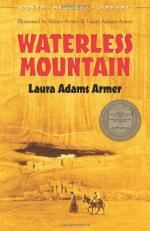|
This section contains 163 words (approx. 1 page at 300 words per page) |

|
Unlike many books about Native Americans, Waterless Mountain does not dwell on the social issues surrounding the conflicts between the white and Native American cultures. Armer acknowledges the existence of such conflicts and mentions the tragic Navajo "Long March," but her primary purpose is to celebrate the vitality of the Navajo culture, not to emphasize events that undermined it. She shows Younger Brother and his people pursuing a traditional way of life as the twentiethcentury technology that threatens traditional ways lurks in the background of the narrative. Younger Brother's interactions with the white characters who appear in the narrative suggest that Armer, perhaps idealistically, hoped that her novel would stand as an example of how white and Native American cultures could live in harmony if each tried to understand the other. Some readers, though, may find Armer's depiction of the Big Man somewhat disturbing, for the...
|
This section contains 163 words (approx. 1 page at 300 words per page) |

|




